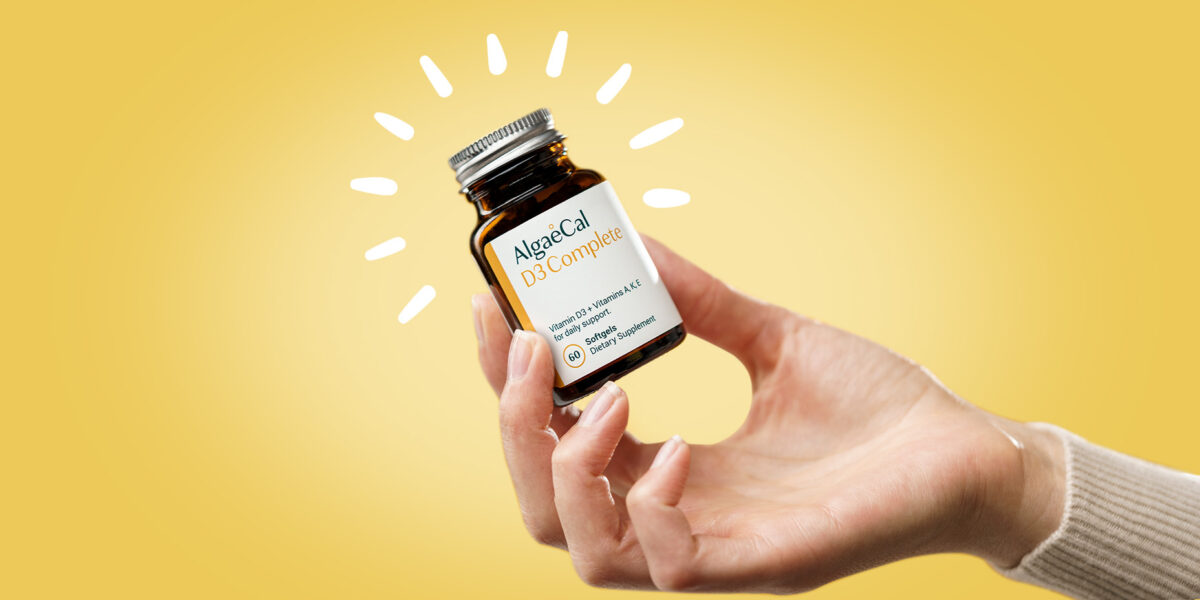As the winter months roll in, we’re all getting ready to hunker down a bit and spend more time with our indoor activities and less time outside. While this time of year can offer an excellent opportunity to slow things down and become more introspective, there is one very significant downside to spending less time outside – lack of vitamin D.
In fact, research shows that due to the latitude of certain areas in the Northern US, sun exposure during the months of November to February results in zero vitamin D synthesis, even on completely cloudless days [1][2].
And while you may be able to get some vitamin D from foods, sunlight is far superior to food, making it the best way to help your body synthesize vitamin D. Among its many duties, vitamin D is essential for the proper utilization of calcium and phosphorus, two minerals that are vital to bone health.
This means that when your vitamin D is low, it can set the stage for bone diseases like osteomalacia and osteoporosis [3][4].
So, how can you enjoy the winter months without worrying about your vitamin D status?
In this article, you’ll learn:
- Why sunlight is so crucial for vitamin D synthesis
- The optimal level of vitamin D that you should aim for
- The best ways to optimize vitamin D production in the winter
- How to supplement with vitamin D to maintain the health of your bones
Vitamin D And Sunlight
Vitamin D is a unique nutrient in that a healthy, well-balanced diet isn’t enough to keep its levels high. Unlike most nutrients that are absorbed and assimilated through your diet, vitamin D is primarily synthesized through your skin with the help of sunlight.
When your skin is exposed to UVB rays from the sun, a compound called 7-dehydrocholesterol absorbs the rays and is converted to vitamin D3. This is just one of the fascinating ways in which your body shows you how highly in tune you are with your environment [5].
Your ancestors lived their lives very close to the earth, communing with the natural world. They would spend the majority of their time outdoors, even in the colder winter months. Today we get to enjoy the luxuries of modern life, which is lovely for many reasons, but it also puts us at risk for vitamin D deficiency.
That said, studies show that just 10-15 minutes of daily sunlight exposure in summer and spring can produce enough vitamin D to meet your needs [6][7]. Of course, several factors can influence your body’s synthesis of vitamin D from sunlight, including season, time of day, latitude, altitude, air pollution, skin pigmentation, level of body fat, and aging [5][8].
While asking you to spend more time outside in the chill of the winter may be a non-starter, luckily, we have modern solutions to our modern conundrum. But before we jump into the best ways to enhance vitamin D synthesis in the winter, let’s review what optimal levels should look like and how you can test to ensure you’re on track.
How To Test And Determine Your Optimal Levels of Vitamin D
The best test for measuring vitamin D levels is the 25-hydroxy vitamin D test, which your doctor can order. This is a simple blood test that will tell you how much vitamin D is in your circulation and give you an indication of whether you need to increase vitamin D synthesis.

What Is The Optimal Level of Vitamin D?
There is some debate about the optimal level of vitamin D in the blood.
For example, some experts suggest aiming for 30-50ng/mL while a study from the Boston University School of Medicine found a range of 40-60 ng/ml was needed to achieve the full range of health benefits conferred by vitamin D [12].
Another study from the University of California found that a higher range of 60-80 ng/ml was associated with a significantly reduced cancer risk [13].
Ultimately, your optimal levels will depend on your current health status and health goals.
When it comes to supplementing with vitamin D, the National Institute of Health recommends that adults under 71 need 600 IU daily, with that number increasing to 800 IU for adults over the age of 71. However, this dosage may be a bit conservative as The International Osteoporosis Foundation recommends a higher dose of 800-1000 IU a day for adults over the age of 60. Furthermore, the Endocrine Society recommends 1500-2000 IU per day for all adults [14][15].
What Are the Symptoms Of Low Vitamin D?
According to an NHANES study, 40% of adults in the United States are vitamin D deficient [15]. And that number increases for people over the age of 65, especially postmenopausal women [9][17].
While a blood test is the gold standard for determining vitamin D levels, you may also want to pay attention to your body for signs of low vitamin D.
Some symptoms of low vitamin D include [10]:
- Muscle pain
- Bone pain
- Increased sensitivity to pain
- Tingly, “pins-and-needles” sensation in the hands or feet
- Muscle weakness in the upper arms or thighs
- Waddling while walking due to muscle weakness in the hips or legs
- Easily broken bones
- Muscle twitches or tremors
- Muscle spasms

What Happens When You Have Too Much Vitamin D In Your System?
Conversely, it’s also possible that you have too much vitamin D, although this is much less common and typically results from over-supplementation. Generally speaking, you would have to consume amounts much higher than what you’d find in daily supplements. For example, taking around 60,000 IU of vitamin D daily for several months has been shown to cause vitamin D toxicity [16].
When you have too much vitamin D in your system, it causes a buildup of calcium in your blood which can create a range of symptoms, including:
- Nausea
- Vomiting
- Weakness
- Frequent urination
- And ultimately could progress to the formation of calcium stones
Can You Get Enough Vitamin D from Your Diet?
While a handful of foods contain vitamin D, even choosing highly fortified foods is not enough to keep your vitamin D levels in a healthy range. For example, 3.5 ounces of wild-caught salmon may contain around 988 IU of vitamin D, and vitamin D fortified milk contains around 100-150 IU [18][19].
As mentioned, this is a unique nutrient that humans have historically received primarily through sunlight.
Although the winter months are a time of year when you likely spend more time indoors, in modern society, it’s rare that anyone is getting enough vitamin D from food or sunlight alone (especially if you live in an area where you aren’t getting sunlight all year). This is why supplementing with vitamin D has become such a crucial part of healthy aging.
Best Vitamin D Supplements To Take During The Winter
Even if you’re young and highly active outdoors, you still likely need a vitamin D supplement for the winter months.
There are hundreds of different vitamin D supplements out there, so when choosing the option that’s right for you, keep in mind:
- You’ll want a supplement with a dose of 600 IU at the minimum.
- You’ll want to see vitamin D3 (cholecalciferol) on the label. There are several different forms of vitamin D, and many supplement companies use vitamin D2, which isn’t as well absorbed or as effective as D3.
AlgaeCal products use vitamin D3 (cholecalciferol), with AlgaeCal containing 1000 IU of vitamin D3 and AlgaeCal Plus containing 1600 IU. Moreover, these products come packed with other bone-building nutrients that all work together synergistically.
Cofactors Needed To Optimize Your Vitamin D Function
In addition to getting enough vitamin D itself, there are several nutrients that serve as cofactors for vitamin D utilization.
These include magnesium, boron, zinc, vitamin A, and vitamin K.
- Magnesium is required to activate vitamin D and transport it around in your blood[20].
- Boron supports vitamin D utilization, with studies showing that it can specifically enhance the impact of vitamin D on bone health[21].
- Zinc plays a role in vitamin D dependent genes, and studies show that low zinc levels predict vitamin D deficiency[22].
- Vitamin A has a synergistic relationship with vitamin D, making the balance of these two nutrients crucial[23].
- Much like vitamin A, vitamin D and vitamin K also have a synergistic relationship which particularly seems to impact bone and heart health[24].
Top 3 Ways to Get Enough Vitamin D in the Winter
#1 Get Outside (When You Can)
Yes, the winter is cold – but with an extra scarf or a puffier jacket, you can still make it out for some outdoor activities now and then. Trying to get outside for a walk several times a week will do wonders for your mental health, as well as help boost your vitamin D.
Pro Tip: The more sun exposure on your skin, the better, so if you’re walking and start to get warm, roll up those sleeves to get some sunlight on your arms.

#2 Incorporate More Vitamin-D Rich Foods
There are several foods that contain a fair amount of vitamin D that you can try to incorporate more of during the winter months.
For example, 3.5 ounces of wild-caught salmon contains around 988 IU of vitamin D, and a 3.5-ounce can of sardines contains 272 IU. Other seafood options that offer a rich source of vitamin D include oysters, tuna, and shrimp.
For the vegetarians out there, mushrooms and eggs are also sources of vitamin D.
#3 Take a High-Quality Supplement
At the end of the day, having a high-quality vitamin D supplement is your fail-safe during the winter months. While it is an excellent idea to get outside and experience some natural sunshine during the winter, the number of hours you would have to spend outside (with your skin exposed) to achieve optimal vitamin D levels is unreasonable for most people.
And even if you stock up on vitamin D during the summer, it’s unclear how much of this becomes available for use in the winter [25].
Likewise, boosting your diet with extra vitamin D is always a good idea, but it’s unlikely to get you to where you need to be.
To avoid the potential downfalls of low vitamin D, provide yourself with a supplement that will keep your body and bones healthy and thriving throughout the winter months.
Takeaway
As the winter sets in, let this season be a time of peace and relaxation. Get ready for some cold nights by the fire, dig into a good book or hobby that helps you feel grounded, get outside when it feels comfortable, and stock up on some delicious vitamin D-rich foods.
For the rest of your vitamin D needs, know that you’re taking care of your body by providing it with the nutrients it needs through high-quality supplementation.
What To Look For In A Vitamin D Supplement
You Don’t Need More Vitamin D. You Need Balanced Vitamin D.
Here’s the truth: your body doesn’t need massive doses of vitamin D. What it does need is a safe and balanced blend of all four fat-soluble vitamins: A, D, E, and K. Why? Because when these vitamins work together, their combined benefits are far greater than what any single vitamin can achieve on its own.
Sadly, most supplements skip this critical balance. And it’s not just ineffective—it’s dangerous.
A report in the British Journal of Clinical Pharmacology found that high doses of vitamin D can damage your heart, kidneys, arteries, and even your brain. Another study revealed that lifeguards with high vitamin D levels were 20 times more likely to develop kidney stones than the general population.
That’s why we created D3 Complete. It’s the only supplement that gives you safe and balanced doses of vitamins A, D, E, and K—so you get all the benefits without the risks.
Because true health isn’t about megadoses of any one nutrient—it’s about the right balance of what actually works.

FAQS
Can I get vitamin D from the sun in winter?
Depending on where you live, you may be able to get vitamin D from the sun in the winter. However, research shows that due to the latitude of certain areas in the Northern US, sun exposure from November to February results in zero vitamin D synthesis, even on completely cloudless days.
How can I increase my vitamin D in the winter?
The best way to get vitamin D is through sun exposure. However, a high-quality vitamin D supplement is an excellent option if you live in a latitude that prevents vitamin D synthesis from the sun.
How much vitamin D should I take during winter?
Since it’s unclear how much vitamin D can be stored from summertime sun exposure, you’ll want to supplement with a dose of 600 IU at the minimum.
What is the best way to absorb vitamin D?
Several cofactors can help you absorb and utilize vitamin D when you take it as a supplement. These include magnesium, boron, zinc, vitamin A, and vitamin K.
References
- Webb, Ann R., Loren Kline, and Michael F. Holick. “Influence of season and latitude on the cutaneous synthesis of vitamin D3: exposure to winter sunlight in Boston and Edmonton will not promote vitamin D3 synthesis in human skin.” The journal of clinical endocrinology & metabolism 67.2 (1988): 373-378./
- Holick, Michael F. “Vitamin D: a d-lightful solution for health.” Journal of investigative medicine 59.6 (2011): 872-880.
- Minisola, Salvatore, et al. “Osteomalacia and vitamin D status: a clinical update 2020.” JBMR plus 5.1 (2021): e10447.
- Lips, Paul, and Natasja M. Van Schoor. “The effect of vitamin D on bone and osteoporosis.” Best practice & research Clinical endocrinology & metabolism 25.4 (2011): 585-591.
- Wacker, Matthias, and Michael F. Holick. “Sunlight and Vitamin D: A global perspective for health.” Dermato-endocrinology 5.1 (2013): 51-108.
- Religi, A., et al. “Estimation of exposure durations for vitamin D production and sunburn risk in Switzerland.” Journal of exposure science & environmental epidemiology 29.6 (2019): 742-752.
- Gani, Linsey Utami, and Choon How How. “Vitamin D deficiency.” Singapore medical journal 56.8 (2015): 433.
- https://ods.od.nih.gov/factsheets/VitaminD-HealthProfessional/
- https://my.clevelandclinic.org/health/diseases/15050-vitamin-d-vitamin-d-deficiency
- https://www.yalemedicine.org/conditions/vitamin-d-deficiency
- Grant, William B., et al. “A narrative review of the evidence for variations in serum 25-hydroxyvitamin D concentration thresholds for optimal health.” Nutrients 14.3 (2022): 639.
- Garland, Cedric F., et al. “Vitamin D supplement doses and serum 25-hydroxyvitamin D in the range associated with cancer prevention.” Anticancer Res 31.2 (2011): 607-611.
- https://www.osteoporosis.foundation/vitamin-d-recommendations
- https://cancer.ca/en/cancer-information/reduce-your-risk/eat-well/eating-well-extras-to-consider
- Parva, Naveen R., et al. “Prevalence of vitamin D deficiency and associated risk factors in the US population (2011-2012).” Cureus 10.6 (2018).
- https://www.mayoclinic.org/healthy-lifestyle/nutrition-and-healthy-eating/expert-answers/vitamin-d-toxicity/faq-20058108
- Capatina, Cristina, et al. “Vitamin D deficiency in postmenopausal women–biological correlates.” Maedica 9.4 (2014): 316.
- Lu, Z., et al. “An Evaluation of the Vitamin D3 Content in Fish: Is the Vitamin D Content Adequate to Satisfy the Dietary Requirement for Vitamin D?” J Steroid Biochem Mol Biol (2007): 642-644.
- https://www.usdairy.com/news-articles/what-type-of-vitamin-d-is-in-milk
- DiNicolantonio, James J., and James H. O’Keefe. Magnesium and vitamin D deficiency as a potential cause of immune dysfunction, cytokine storm and disseminated intravascular coagulation in COVID-19 patients.” Missouri medicine 118.1 (2021): 68.
- Pizzorno, Lara. “Nothing boring about boron.” Integrative Medicine: A Clinician’s Journal 14.4 (2015): 35.
- Amos, Ashton, and Mohammed S. Razzaque. “Zinc and its role in vitamin D function.” Current Research in Physiology (2022).
- Yee, Michelle Min Fang, et al. “Vitamin A and bone health: a review on current evidence.” Molecules 26.6 (2021): 1757.
- Van Ballegooijen, Adriana J., et al. “The synergistic interplay between vitamins D and K for bone and cardiovascular health: a narrative review.” International journal of endocrinology 2017 (2017).
- Martinaityte, Ieva, et al. “Vitamin D stored in fat tissue during a 5-year intervention affects serum 25-hydroxyvitamin D levels the following year.” The Journal of Clinical Endocrinology & Metabolism 102.10 (2017): 3731-3738.





susie welling
January 22, 2022 , 9:23 amI’ve taken algecal for years. I am out of it and need it.
I can’t seem to get that across.
I have my own strontium and when it’s gone I’ll get yours.
Please help me get algaecal.